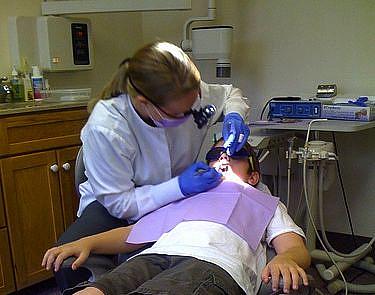School-based health centers partner to offer mental health, dental care

While school-based health centers in California and nationwide have increased students’ access to health care, some children and teens still have limited access to needed services, like behavioral health and dental care.
School health centers are adapting to this challenge by partnering with existing community organizations, said John Schlitt, vice president of policy and government affairs at the National Assembly on School-Based Health Centers. “It’s about building a continuum of care with community partners,” Schlitt told me in a phone interview.
The Dr. John T. Macdonald Foundation School Health Initiative in Miami exemplifies this approach. The initiative recently received a Health Care Innovation Award of $4 million over three years from the Centers for Medicare and Medicaid Services to expand the initiative’s mental health services and dental care offerings.
The initiative operates nine school-based health centers in medically under-served areas within the Miami-Dade County Public School system. The health centers serve a community that is about 60 percent Haitian and 30 percent Latino and that faces multiple barriers to accessing health care, including a lack of insurance, transportation or documentation.
Given those challenges, it’s fulfilling to work in a school-based health center, “just knowing that you have the capacity to treat children that otherwise may not even set foot into the traditional doctors’ office setting or even go to the emergency room,” medical director Dr. Jocelyn Lawrence told me in a phone interview.
The grant enabled the hiring of two psychiatry residents, who now work at the clinics twice a week, through a partnership with a community hospital. This should prevent a common problem, Lawrence explained: The school health centers often referred students to mental health care providers in the community, but few actually made it to their appointments. The grant also allowed the initiative to hire community health workers, who can follow up with students about their behavioral health needs. “We’re hoping that no child will fall through the cracks,” she said.
“It’s a huge need,” Lawrence said of mental health services. “Often our social workers are more busy than our nurses.”
The grant has also allowed the initiative to partner with another university, so the schools’ nursing staff could learn to provide students with fluoride varnishes. Lawrence views this as preventive care; in the past, the initiative offered a sealant program for second graders, but 33 percent of them already had cavities and were therefore ineligible for the treatment, she said. Sixth grade students can receive more extensive dental treatments, like fillings and root canals, at a community partner’s local office.
The nine clinics now have an electronic medical record system that will link students’ medical and academic records. It will make it possible for medical providers to see students’ test scores and number of absences. This underscores the overarching need for school-based health centers: “If they’re healthy, they can do well academically,” Lawrence said.
Finally, the grant is allowing the initiative to fill another gap: Parents’ need for health care. Now, if parents come to a school-based health center seeking care, staff can refer them to another local partner, the Center for Haitian Studies in Miami, which will provide free health care services to adults and children. “It’s a lot harder to provide free care to adults because of their chronic list of problems,” Lawrence said.
Community partnerships with local academic institutions have added much to the program, Lawrence said. These partnerships provide huge benefits not only to students and the community, but also to the medical residents, nurse practitioner students, and psychiatry students. “It’s great exposure for them, from the community health aspect,” she said.
Image by Melissa Clark via Flickr

